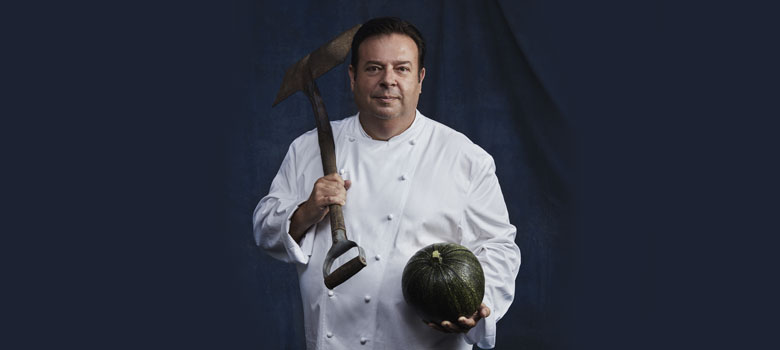
Food
Peter Gilmore - From plant to plate
Renowned chef Peter Gilmore has had to close his beloved restaurants, Bennelong and Quay, due to the coronavirus crisis. Their location, with sweeping views of Sydney Harbour, could not be more iconic, but it’s also why neither can pivot into takeaway like others have been able to do.
"There is no walk-in trade around Circular Quay, so unfortunately we were forced to close," says Peter. "I am confident we will find a way forward; we just hope it doesn’t take too long."
So instead, Peter is hanging out at his home on Sydney’s Northern Beaches, where he is tending his vitally important vegetable garden and planning his next surprise innovation.
Peter Gilmore has been working as a chef since he was 16 years old, but it was after stints in the UK and the Blue Mountains that he made his biggest impact as Head Chef for De Beers Restaurant at Whale Beach. "While I was working overseas, I was exposed to some really unique produce from the West Country in south western England, as well as France. Although I learnt some great techniques, it was frustrating that a lot of the produce I worked with there was not available back in Australia."
In 2001, he moved to Quay to become its Head Chef. Within a year Quay was named Restaurant of the Year and received its first Three Hat ranking in The Sydney Morning Herald’s Good Food Guide, an award Quay has held for 18 consecutive years, an industry record.
Peter says his style really came together when he started gardening back in 2008. He started to grow a lot of the unique produce he had seen in Europe and discovered there was a multitude of rare and heirloom vegetables not being grown commercially. He then started to approach farmers to grow these vegetables for the restaurant. This led to more creativity and a deeper appreciation for nature. "At that time, the molecular thing was huge, but I went in a different direction exploring nature’s diversity and heirloom vegetables. Michel Bras and Alain Passard were two chefs I considered to be pioneers in working with a more natural style."
"I guess international recognition came in 2010 when Quay was included in the World’s 50 Best Restaurant list, it was also the year I released my cookbook Quay, not to mention a little dessert called the Snow Egg."
GROWING NEW FLAVOURS
Peter’s home vegetable garden is crucial in planning his menus.
"I will generally grow it at home first, to make sure it’s something I want to use," he explains. "Often you read about a new type of veggie that sounds interesting, but until you’ve grown it and tasted it, you can’t work out what to do with it! Observing them during different stages of growth adds to my creative pallet. They might taste super sweet when young, but maybe you want them left longer to develop flowers and seed pods."
Peter sources his produce from all over Australia, whether that be wild barramundi from North Queensland or sea succulents from Kangaroo Island.
"Australia gives us 98 per cent of everything we need in the kitchen," Peter says, "and there’s not many countries that can do that."
But when it comes to his vegetable growers, all of whom are situated closer (e.g., Newcastle Greens, Epicurean Harvest in the Blue Mountains, and Boon Luck Farm near Byron Bay), it’s a more symbiotic relationship.
"It’s a real commitment to ask one of my farmers to grow me something new," Peter explains. "Because if I discover a new turnip, I will need 1000 of them each week for the menu for the season so I’ve got to be really sure that it’s exactly the type of turnip I want. This is a huge commitment for the farmers, and it becomes a real partnership. A new ingredient can be the starting point for a new dish, and this is how I found my own voice and style."
"I’m using more rare ingredients than ever before because cooking should always push and evolve. The challenge is to honour these ingredients and discover the best way to cook them to accentuate their natural essence."
Peter sources seeds from the length and breadth of the country, and also imports some from overseas. "I am always looking for something I haven’t grown before. I also see it as my mission to save seeds because if these rare vegetables are not grown, and seeds not saved, we will lose their genetics." Peter published a book on the subject in 2018 (From the Earth).
A NEW CRAFT
Whilst his wife is suggesting he use his down time to write a book about home recipes ("and that might happen, you never know", Peter says), he is focused on learning a whole new craft – ceramics!
"We have commissioned leading Australian ceramic artists to make the plates at Quay and Bennelong for a number of years," he explains, "and after working closely with local potters and ceramicists, I want to learn how to do it myself."
"I have always been involved with the design, size, shape and colours," he enthuses, "with new plates being designed around a specific dish. Occasionally the plate design has come first, and that has sparked an idea for a new dish. There is so much out there still to discover."
While the world will be forever changed when we come through this global crisis, Peter Gilmore will provide some consistency in his always innovative approach to food.